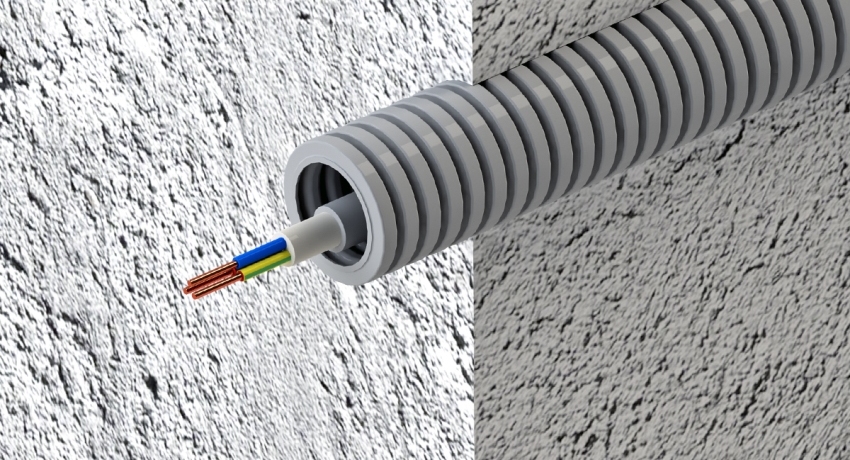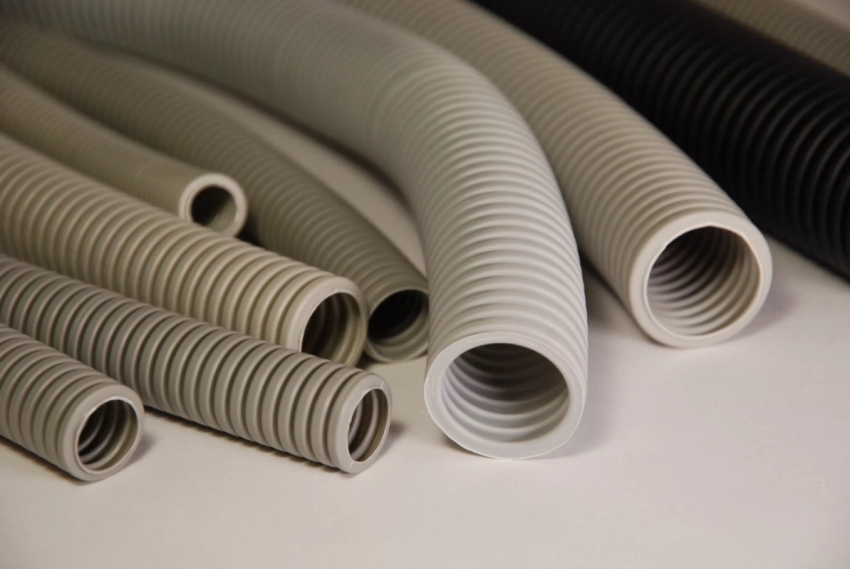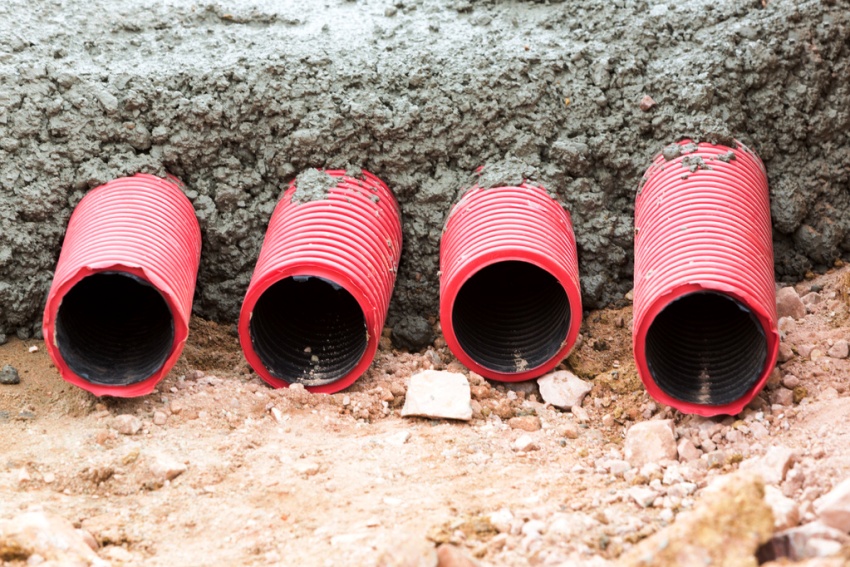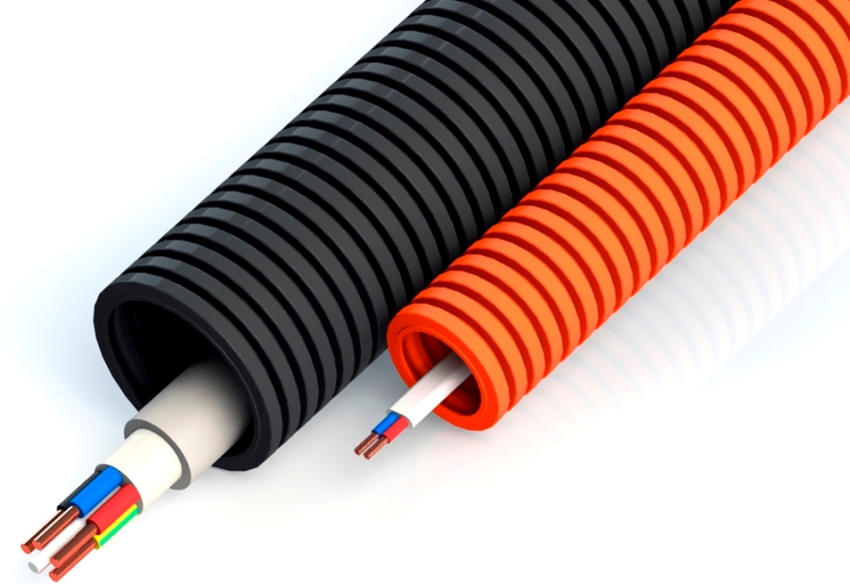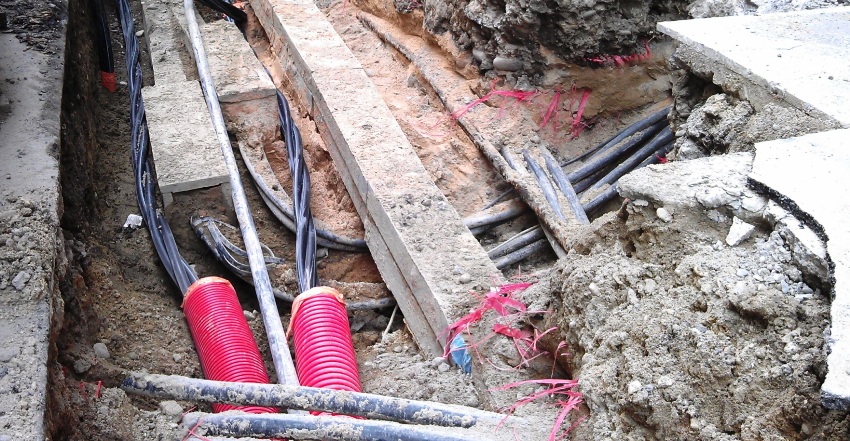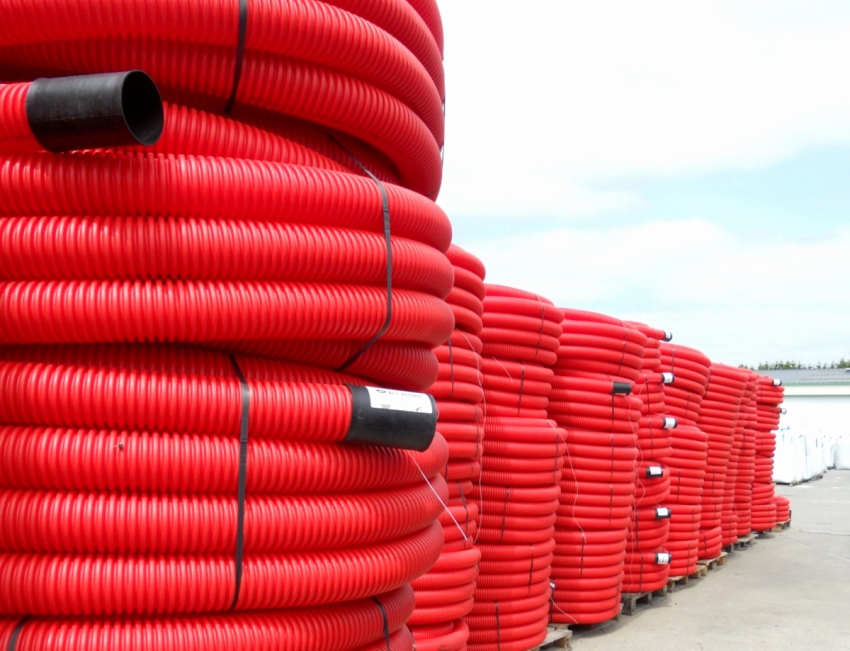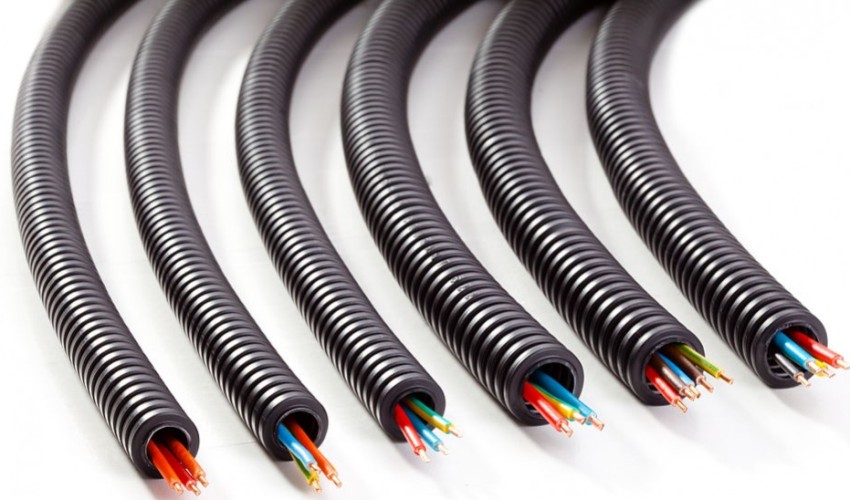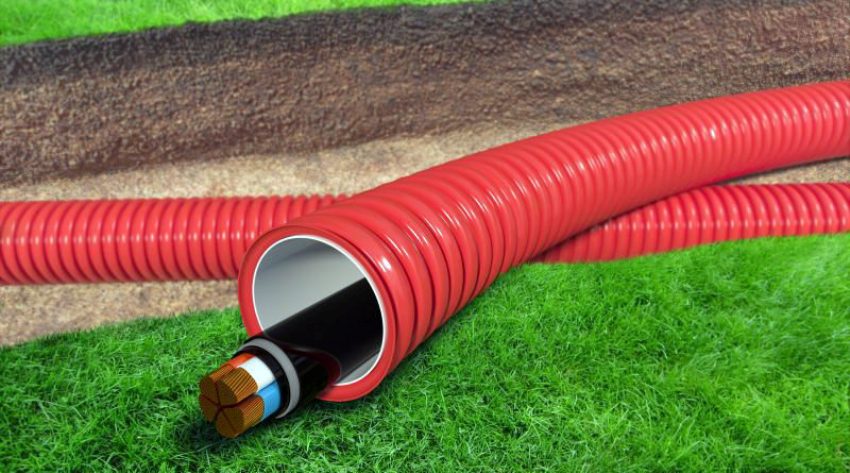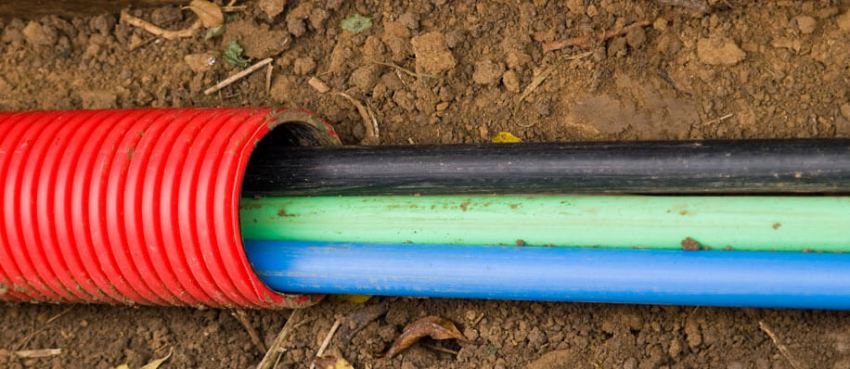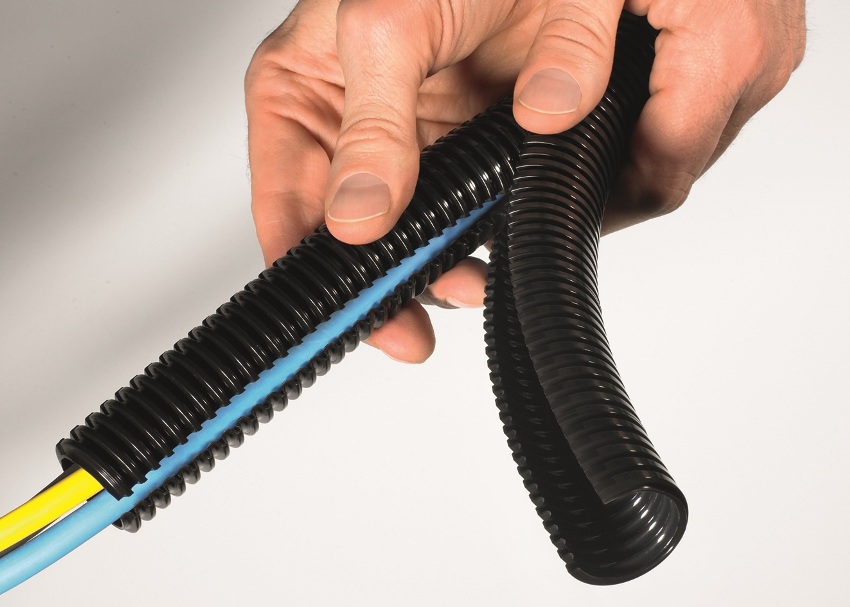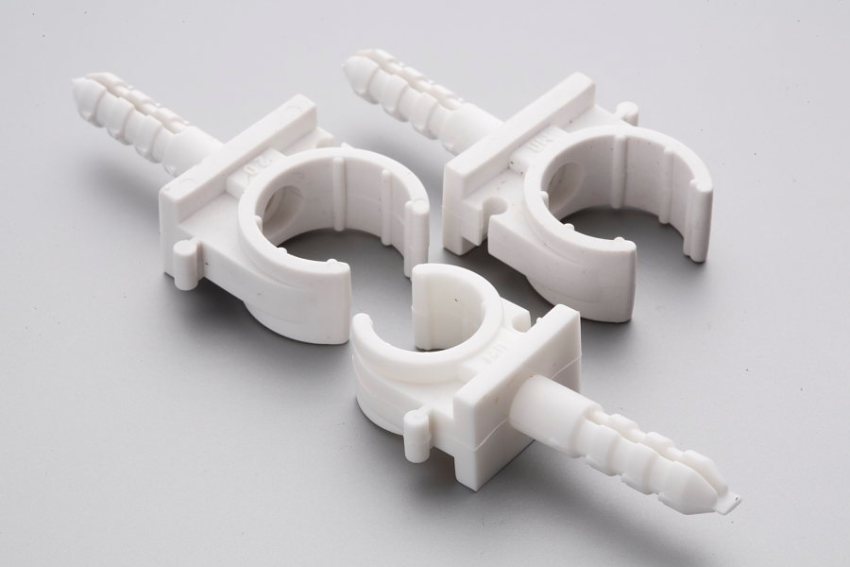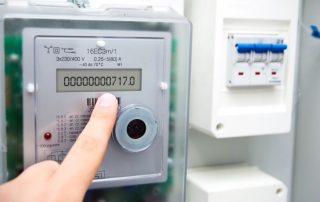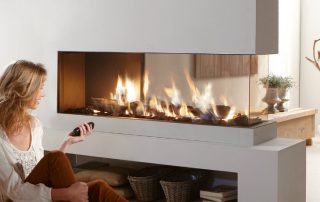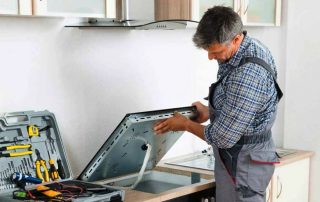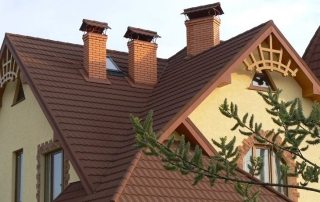Products made from polymers are increasingly being used. Ribbed corrugation for cables has not been used for so long, but it is the best option of all technological innovations for protecting power grids. Lightweight, compact and flexible PVC channels retain their shape, replacing outdated technologies. The selection criteria and installation features of the protective corrugation made of polymers should be understood in more detail.
Content
- 1 What is polymeric corrugated pipe for cable
- 2 Corrugated cable laying: types of flexible products
- 3 Technical corrugation for cable and its classification
- 4 Properties of double-walled electrical corrugation
- 5 Advantages and disadvantages of corrugated HDPE pipes
- 6 How is installation carried out: clips for corrugation
What is polymer corrugated pipe for cable
The corrugation for electrical wiring is a flexible PVC pipe. Thanks to their properties, including increased flexibility and elasticity, polymer products facilitate the installation of power grids in hard-to-reach and heavily loaded places. For example, in houses built in earthquake-prone regions, it is easier to protect electrical wiring isolated in this way during vibrations.
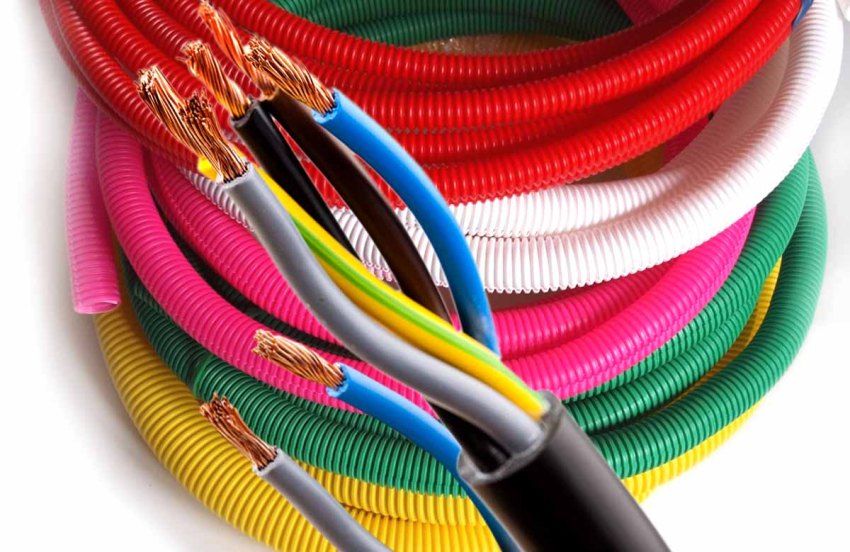
The corrugation is made of PVC-compound, which does not support combustion for a certain period of time
Protection in the form of polyvinyl chloride pipes is also the possibility of combining several wires in one channel. This method is used for the installation of complex multi-component wiring, lighting design and suspended ceilings with combined lighting. The scope of application of corrugated pipes is quite wide. Modern enterprises produce several varieties of special-purpose products.
Corrugated PVC pipe for cable, as a rule, has a small diameter, which eliminates the need to groove a deep and wide channel for hidden installation. It is produced in bays, in such packaging it is convenient to carry and transport.
Important! Low prices for polyvinyl chloride are an insignificant additional payment for the quality, reliability and speed of electrical installation during the construction of new and reconstruction of old facilities.
Polymeric materials from which the pipe for laying cables is produced have a lot of positive properties. For example, if a fire occurs due to a short circuit, the rapidly extinguishing polymer prevents the fire from spreading.
PVC pipe for electrical wiring is also excellent insulation and safety, which is important not only in residential buildings, but also in industrial conditions. It is much safer to lay a high voltage cable during repairs, knowing that the polymer product protects against electric shock.
Corrugation for wires and its most important properties
The corrugated structure is capable of withstanding tremendous pressure and mechanical stress, which no smooth pipe can demonstrate under the same conditions.
Convenience of using PVC corrugations for wiring is beyond doubt. The advantage of insulated mounting is that it is easy to perform at any angle, even on the surface of vaults and arches.
In hard-to-reach places and on curved sections, hidden highways are very problematic to do in another way. It is the flexibility of the product that guarantees high-quality installation of the electrical cable with exact repetition of complex bends for any architectural features.
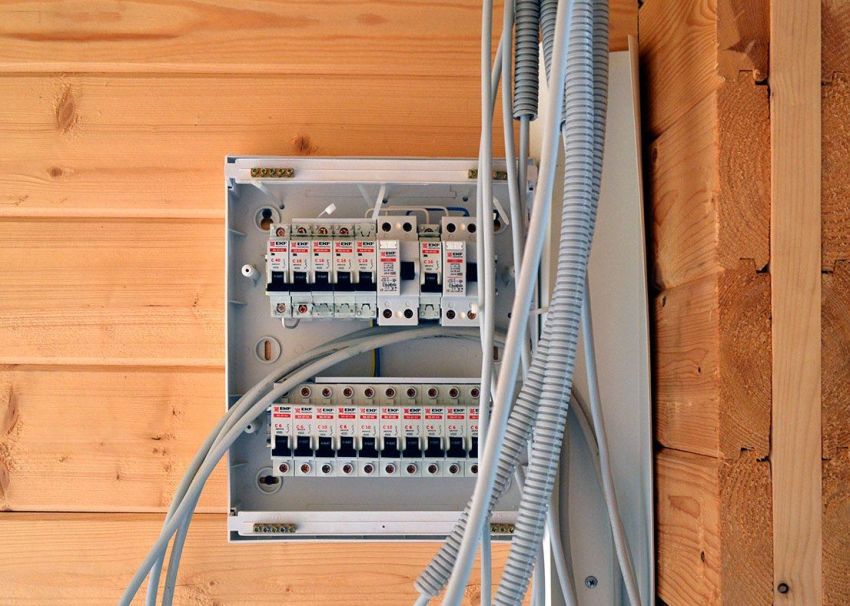
The main purpose of the corrugated pipe is to use it as a channel cable in the process of arranging electrical networks
A flexible corrugated pipe with a small cross section makes it possible to install complex joints and turns, up to a 360 ° turn. The cable, embedded in the hidden groove, fills it evenly, reducing the cost of plastering surfaces after the initial stage of installation.
In modern construction, corrugated pipes are mounted not only inside buildings, but also outside them, which is used in organizing a power network for objects with outdoor lighting, especially in suburban households. For some time now, the installation of power grids is quite rare without the use of flexible insulation. In certain cases, landscape design is taken into account. For example, it is recommended to use a red corrugation for the night light cable:
- paths and flower beds;
- pool or fountain;
- baths and saunas;
- artificial reservoir;
- areas for barbecue and barbecue;
- covered gallery or terrace.
Convenience in work is an important argument for the use of corrugations for laying cables in the ground and during outdoor work. It is cut with metal scissors or other suitable devices.
Corrugated cable routing: varieties of flexible products
At the moment, the protective polymer sleeve is available for various construction needs, including sewer corrugation and cable protection for various voltage cables. Depending on the properties of the polymer and the size of the corrugation for the cable, experts recommend using it for different types of wiring:
- for power cable;
- for low-current networks (telephones, television and computer UTP wire).
The protective corrugation, in accordance with the purpose, is produced not only in polymer, but also in metal versions. Flexible tubing products differ in material, color and design (for example, there is a double corrugation). A cable is pulled inside the product, often not even one - it all depends on the working conditions and the type of wiring:
- hidden inner;
- outdoor;
- underground.
Useful advice! When buying, pay attention to the thickness and section of the corrugation, so as not to overpay for unclaimed properties. The cable should run easily inside the sleeve.
There is another type of product classification - according to the degree of strength:
- light pipes;
- heavy;
- superheavy.
Lightweight corrugation is used for concealed installation inside a building (UV-sensitive). Heavy and dense corrugated products are manufactured for underground laying (they are highly pressure resistant).
For the convenience of determining the purpose, a conventional color designation is used, which is reflected in the table:
| P / p No. | Corrugation color | Scope of application |
| 1. | Grey | Standard electrical wire |
| 2. | White | Computer networks, Internet |
| 3. | Green | Telephone or other low voltage cable |
| 4. | Red | External power cable |
| 5. | Blue | In the "warm floor" system and flexible water pumps |
| 6. | Yellow | Gas supply needs |
| 7. | Corrugation black and brown | Insulated wires of household appliances and other electrical appliances |
This is a general industrial building standard, but it is not always adhered to, especially if there is a small stock of product in the coils in the remainder after a large amount of work.
How is the cable laying in the corrugation and dismantling carried out, is a probe needed
Before the advent of protective flexible PVC pipes for electrical systems, the cable was directly walled into a recess in the wall. Installation was complicated by the fact that the open ends were screwed to a bus or other support passed through a piece of metal pipe. In case of emergencies or malfunctions, the cable was removed from under the plaster (with the risk of damage).
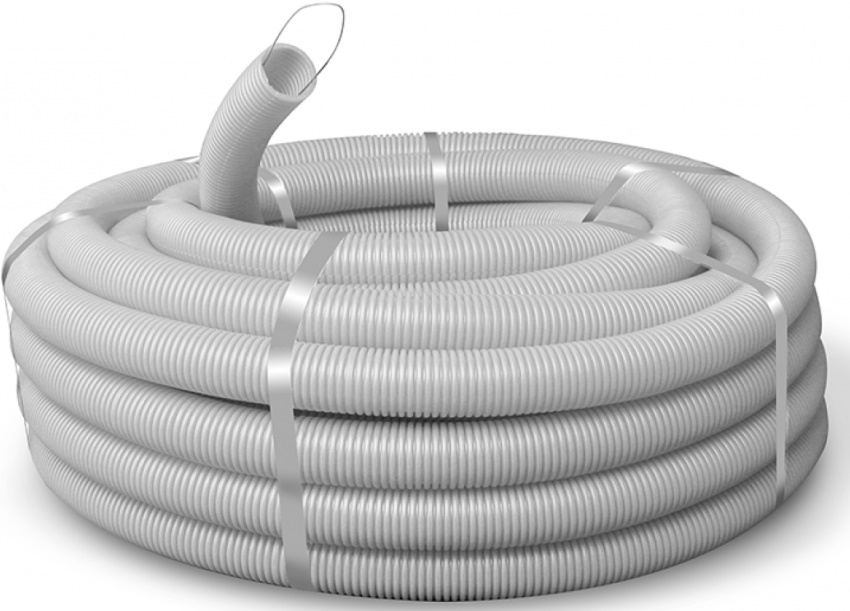
In most cases, manufacturers make a corrugated pipe with a broach for ease of laying electrical networks
A closer look at the range of current offerings in this area of application, it becomes apparent that the sale is a conventional hollow corrugation and a product with an internal probe. It is often called "broach" - and this is its purpose.
Useful advice! Think about how to run the wire inside the corrugation. The best option when, when installing the system, it is possible to hook it and quickly pull it.
The probe, if provided, is always visible inside the polymer tubes. It is a thick metal wire that runs along its entire length inside. The protective sheath for the wiring is cut along with the probe as needed.
It is very simple to use the broach: by hooking the wire with the end of the probe, the cable is pulled through the entire length of the polymer tube. The probe is a guarantee of the convenience of filling the tube with an electric cable. The simplest engineering solution confirms the adage that everything ingenious is simple. Only by pulling the electrical cable inside the corrugation for a great length, you can appreciate the simplicity and wisdom of this solution.
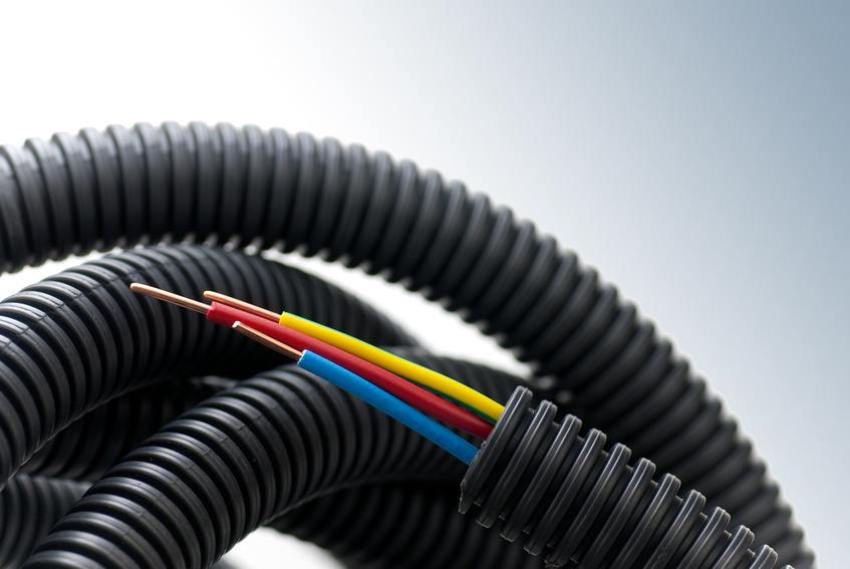
The corrugation is very flexible, but at the same time has stiffening ribs - protection of the cable from mechanical damage
On small-sized sections of corrugated pipes (for example, when there is a need to insulate the wire connection), the probe is not used.
Attention! Doubtful savings are not justified by purchasing without a probe inside the corrugation for the cable: the price differs insignificantly, and work without a probe slows down almost twice.
The convenience of using the corrugation also lies in the fact that the cable is protected without special tools and does not require much effort. You only need an internal probe and a cutting tool, after which the cable is laid in the prepared grooves (grooves).
When dismantling the old wiring loop, the corrugated sleeve does not need to be removed from the groove under the plaster. Once the wires have been removed from the insulating cavity, the probe is no longer required. The corrugation hidden in the strobe can remain in it, which eliminates the need for repairs. It is enough to remove the desired piece of the electrical cable by pulling on its end. It is recommended to fill the empty corrugation with foam at the edges.
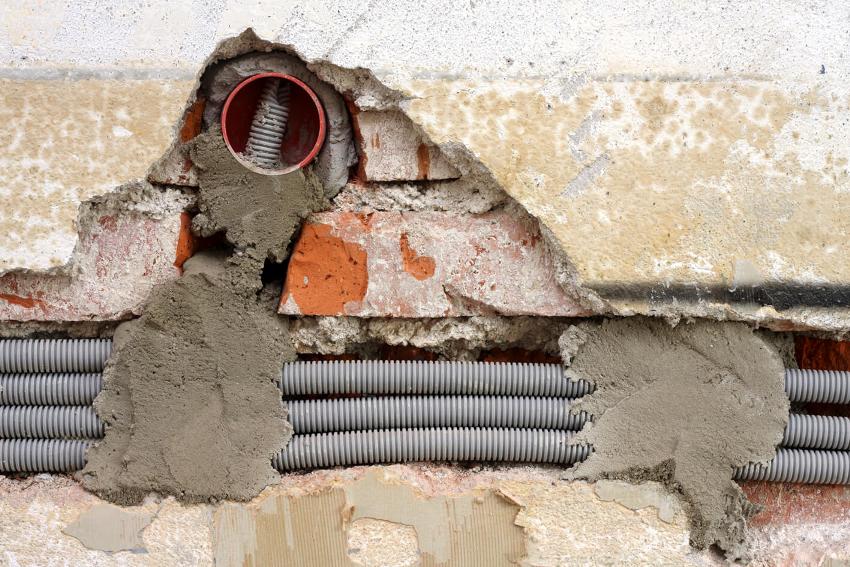
When dismantling the old electrical wiring, the corrugated pipe does not need to be removed from under the plaster
Technical corrugation for cable and its classification
A variety of cable corrugations, diameters, differences in cross-section and thickness allow it to be used for various purposes.
Related article:
Cable ducts: dimensions and product classification
Cable channels: dimensions and parameters of products. Classification of existing structures by type of material. Average prices and additional components.
Common thin-walled products are lightweight, flexible, least pressure-resistant sleeves. Although they are applicable for both outdoor and indoor work, most often the sleeve is hidden in specially prepared niches, where there is no great pressure. Corrugation is also used:
- inside frame and false structures made of gypsum plasterboard;
- in stretch and false ceilings;
- in protective wiring of cars;
- when installing vertical metal supports.
High strength products are heavy PVC pipes that are designed for sufficient mechanical stress, including temperature extremes and difficult operating conditions. They can be poured into concrete structures, mounted under a large layer of plaster or underground at a shallow depth - when the cable is transferred to neighboring buildings.
The extra-heavy corrugation is designed to provide maximum protection of power grids from possible damage. It is used in cases where the wiring is laid in places that require the highest level of security.
The parameters of the protective corrugation for the cable vary - in the range of 16-50 mm in the outer diameter and from 10.7 to 40.2 mm in the inner dimensions.
Recommendations for choosing a product in accordance with its diameter:
- for a closed loop of thin wires connected to coaxial networks, sockets, computer and telephone networks, when installing electrical appliances and alarms, a diameter of 20 mm is sufficient;
- installation of electrical wiring between junction boxes and connection of electrical panels is carried out using products with a diameter of 32-35 mm;
- cable connection between floors - up to 40-50 mm.
The material is sold in coils of 25 - 100 m, most often with a probe or broach to facilitate filling of flexible hoses. For ease of transportation, the coils are packed in heat-shrinkable polyethylene.
Types of materials:
- ordinary PVC (self-extinguishing polyvinyl chloride);
- the most plastic HDPE (low pressure polyethylene), used in turning and curved construction sites;
- LDPE (high pressure polyethylene) for hidden laying in solid materials that are not subject to fire, polyethylene is also used for the manufacture of the outer shell of a two-layer corrugation;
- PA (polyamide) with maximum protection against moisture penetration;
- PP (polypropylene) for cable routing in channels of monolithic structures.
Areas of application of super heavy polymer corrugation
Super-heavy PVC pipe can handle increased stress and pressure when buried at sufficient depth. It can protect communications under the roadbed and building foundations, near bridge supports and fences. At the same time, the cost of laying a cable in a corrugation increases insignificantly, mainly due to the cost of more expensive thick-walled pipes used for outdoor work.
If thin corrugated sleeves are laid under the plaster of vertical walls, then the large format is hidden in a concrete ditch - under the roadway, asphalt parking lot.
Useful advice! It makes no sense to purchase such products because of the increased reliability of the super-heavy corrugation, if difficult operating conditions are not assumed.
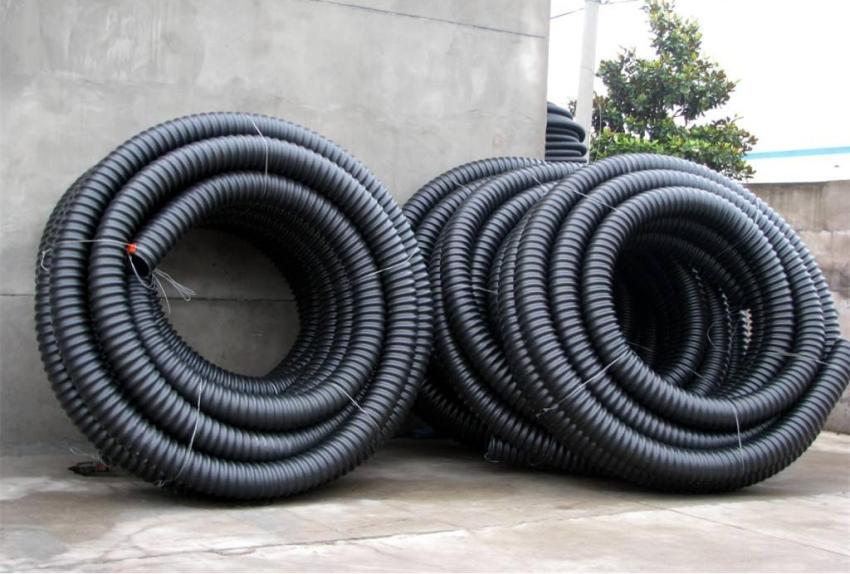
Super heavy polymer corrugation is used for underground laying (most often chosen for a summer cottage and for industrial purposes)
It is better to buy a PVC product in accordance with the technical specifications or choose a metal corrugation for the cable if an increased load is likely.
The choice of this type of product can be dictated by concern for safety when it comes to laying the electrical network in the construction of buildings designed for a large crowd of people, such as:
- schools and other educational institutions;
- shopping and entertainment centers;
- hotels and hotels;
- hospital institutions;
- monolithic industrial buildings;
- train stations and other transport infrastructure.
The high flexibility of the super-heavy corrugated pipe allows the cable to be used on turning and curved sections for various purposes. Such products are used for additional insulation of electrical wiring from moisture, chemicals and mechanical stress. Polymeric street corrugation for cable has a high fire safety, especially if it is made of self-extinguishing PVC. It prevents the spread of fire in the event of unexpected ignition due to possible accidents.
Classification of PVC products and metal hose for cable according to the level of fire safety
Recently, there has been an increasing demand for the use of fire-resistant materials in infrastructure construction. Experts recommend using corrugated pipes for cables, based on the degree of their fire safety:
- For laying inside non-combustible structures (concrete goods, brickwork, concrete frame, monoliths), any corrugated sleeves are applicable.
- In hollow structures made of non-combustible materials, a corrugation that does not support combustion (PVC, LDPE and metal protection) can be used.
- Installation inside ceilings made of flammable materials (wood cladding, gypsum board, composite shields) requires the use of fire-resistant pipes, preferably with special impregnation. Flammable plastic should not be used in these environments.
- Open cable routing is carried out from materials that do not spread combustion (installation is carried out at a distance from flammable coatings).
- Corrugation made of self-extinguishing polyethylene (LDPE) and polyamide (HDPE) is used for external wiring inside rigid structures.
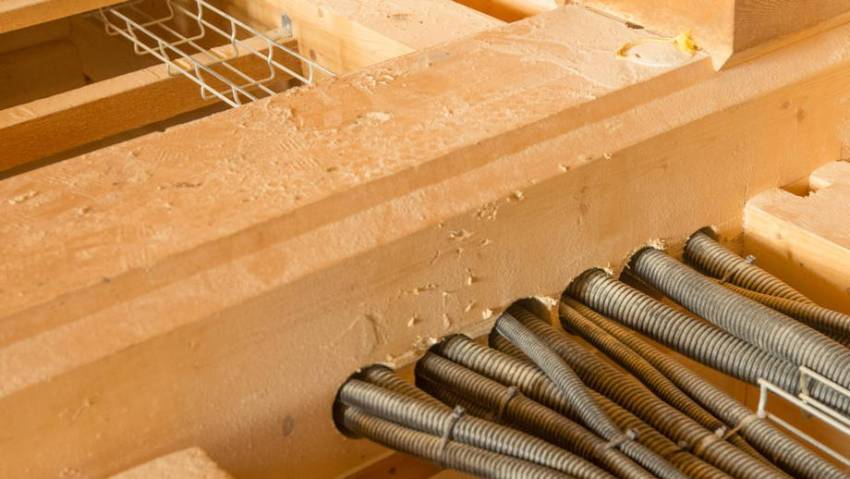
It is recommended to use corrugated pipes and metal hoses for the cable, based on the degree of their fire safety
Attention! The laying of power grids in explosive buildings is carried out inside flexible metal hoses and materials protected from magnetic fields. Plastic pipes, according to GOST, are not intended for these purposes.
Properties of double-walled electrical corrugation
When choosing products for construction needs, it is important to pay attention to the technical parameters and the availability of certificates. The most reliable is considered to be a double reinforced pipe made of different polymers, which has:
- outer ribbed cover;
- smooth inner layer.
These design differences contribute to the strength and ductility of these products. The increased throughput is provided by a smooth wall inside the HDPE sleeves, which correspond to the diameter of the cables. Products are produced in "classic" and combined (HDPE plus LDPE) types.
In reinforced structures, a foil (metal) layer can be used. This provides protection against increased stress and mechanical pressure. Rigid double corrugation guarantees a high coefficient of stiffness, the reinforced HDPE corrugated hose is produced with a large section. These pipes are designed for difficult operating conditions - under the soil and inside the raised floor, under tension floors and inside the cement screed.
Important! It is forbidden to use an electrical corrugation for transporting liquid media, for example, for supplying hot water to an outdoor shower or boiler. For such purposes, it is better to use a two-layer piece of metal hose.
Advantages and disadvantages of corrugated HDPE pipes
Each polymer product has its own undeniable advantages and disadvantages. Among the advantages of protective sleeves, experts note:
- resistance to large temperature ranges (from −30 ° C to +90 ° C);
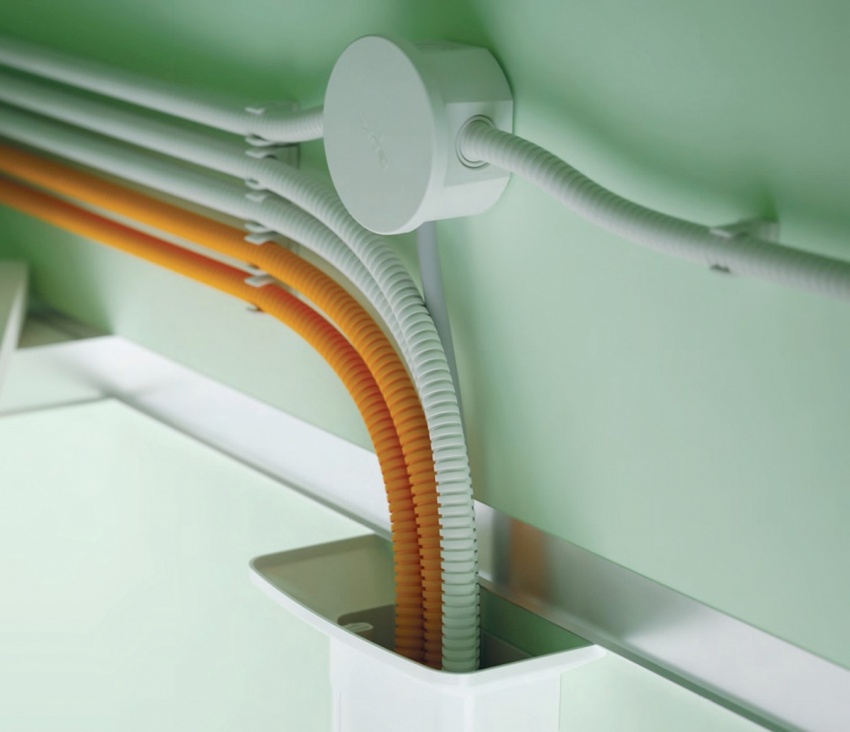
Corrugation provides additional moisture insulation for electrical wiring, which is important for rooms with high humidity
- ease of installation of corrugations at any time of the year and in difficult climatic conditions;
- sufficient tensile strength due to stiffening ribs;
- available installation and easy cable pulling in corrugation for outdoor and indoor use;
- plasticity ensures the laying of any circuit, in most cases without fittings;
- in case of an emergency and partial destruction of structures, the corrugation is slightly stretched or narrowed, so that the cable inside does not break;
- resistance of polymers to corrosion, chemicals and soils of various acidity;
- long service life (up to 40-50 years);
- availability (if we talk about metal corrugation for a 16 mm cable, the price per meter is 11-15 rubles).
Among the possible cons:
- weak resistance to the destructive effects of ultraviolet radiation in external wiring;
- fire hazard in unprotected plastic.
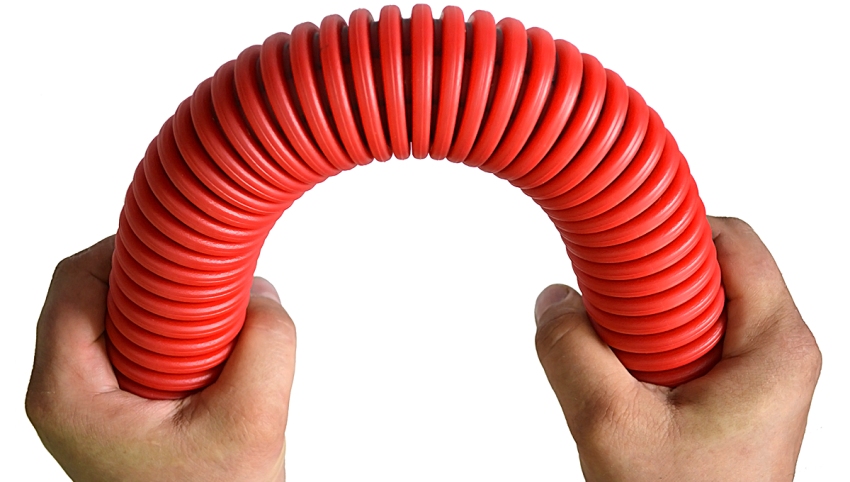
In an emergency, the corrugation is stretched or narrowed, so that the cable inside it does not break
How is the installation carried out: clips for corrugation
For the installation of a corrugated structure, a sufficient range of accessories is offered, including a broaching probe and clips for 16 mm corrugation - the price is within 5 rubles per 1 piece.
Plastic mounting brackets can be combined with nails if the surface material is suitable for the fastening.
Important! The cost of laying a cable in a corrugation is relatively low - this does not significantly affect material costs when replacing all systems.
In the grooves (grooves inside the walls), laying is carried out under rapidly solidifying solutions (alabaster or starting plaster).
Special clips for outdoor installation are available in different formats - taking into account the pipe diameter, for example, clips for a corrugation of 20 mm. It is possible to use clamps left over from construction and installation work, especially for laying inside ventilation and other boxes when combining communications.
It is quite possible to organize a secure installation of hidden communications with your own hands if the corrugated product is correctly selected in diameter. To do this, the wall is preliminarily grooved, making the marking with a special tool to make a groove. The approximate cost of laying a cable in a corrugation per running meter is specified with a specialist of a construction company. The dimensions and cost of laying the cable in the corrugation are reflected in the estimate in advance.
The open type of cable installation is performed behind gypsum plasterboard walls and behind a tension cloth, using brackets and special clips. They are installed at the same interval, eliminating sagging on a horizontal surface. The cable inside the warm floor is mounted on a special grid.
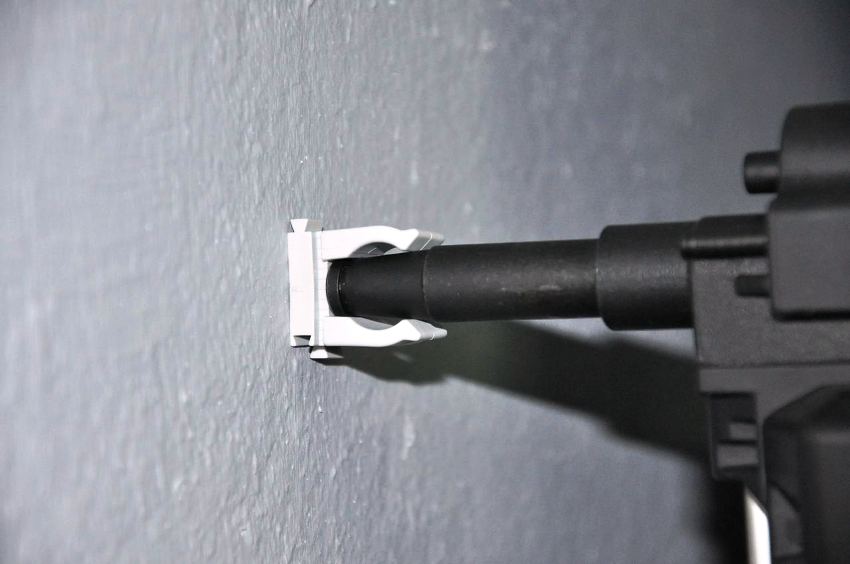
Depending on the wall material, the clamp can be secured either by screwing in a screw or in a pre-drilled hole
As you can see, before purchasing protective products for electrical wiring, it is worth considering all the characteristics and clarifying how to stretch the cable into the corrugation. When laying the electric cable inside the corrugation for a large section, it is desirable to have a probe in order to simplify the broach. Extra heavy double corrugation is applicable only for underground cable laying and inside floors with increased load. In domestic conditions, independent installation of lightweight products is available if the cable cross-section is less than the diameter of the corrugated sleeve.
